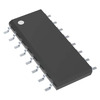Manufacturer Part Number
BQ2054SNTR
Manufacturer
Texas Instruments
Introduction
The BQ2054SNTR is a high-performance, intelligent battery charge management IC from Texas Instruments, designed for Lithium-Ion batteries. It is packaged in a 16-SOIC form factor and is suitable for surface mount technology.
Product Features and Performance
Intelligent charge management for Lithium-Ion batteries
Features fault protection mechanisms for Over Current and Over Voltage situations
Supports a maximum supply voltage of 5.5V
Operates in a temperature range of -20°C to 70°C
Designed for easy surface mount application with a 16-SOIC package
Product Advantages
Enhances battery performance with efficient management
Provides robust safety features to protect against common battery faults
Optimized for Lithium-Ion batteries, ensuring suitability for a wide range of applications
Facilitates easy integration into systems with its surface mount packaging
Key Technical Parameters
Battery Chemistry: Lithium-Ion
Voltage Supply (Max): 5.5V
Operating Temperature: -20°C ~ 70°C
Fault Protection: Over Current, Over Voltage
Quality and Safety Features
Incorporates over current and over voltage protection to safeguard battery operation
Compatibility
Specifically designed for Lithium-Ion battery cells
Application Areas
Ideal for use in portable devices, consumer electronics, and power management applications requiring efficient charging and battery management
Product Lifecycle
Marked as Last Time Buy, indicating that it is nearing the end of its production lifecycle. Users are advised to consider future availability of replacements or upgrades.
Several Key Reasons to Choose This Product
Reliable battery charge management from a reputable manufacturer, Texas Instruments
Enhanced safety features mitigate risk of damage from overcurrent and overvoltage
Optimized performance for Lithium-Ion batteries enhances device reliability and longevity
Suitable for a wide range of applications, thanks to its versatile compatibility and operational parameters
The nearing end of its lifecycle implies an opportunity to stock up for long-term usage or to consider upcoming replacements for newer designs




 BQ2057Texas Instruments
BQ2057Texas Instruments BQ2053BQ
BQ2053BQ BQ2057CDGKRG4Texas InstrumentsIC BATT CHG LI-ION 1CELL 8VSSOP
BQ2057CDGKRG4Texas InstrumentsIC BATT CHG LI-ION 1CELL 8VSSOP BQ2057CSNTRTexas InstrumentsIC BATT CHG LI-ION 1CELL 8SOIC
BQ2057CSNTRTexas InstrumentsIC BATT CHG LI-ION 1CELL 8SOIC